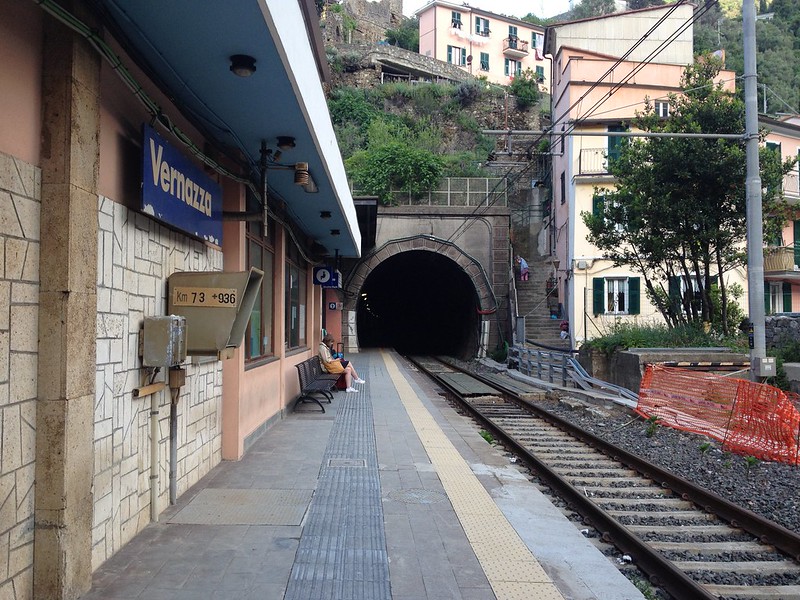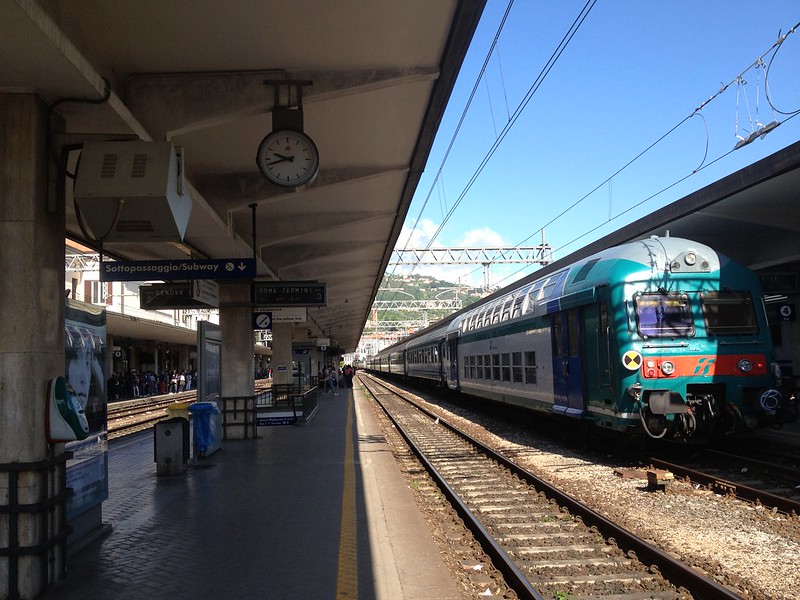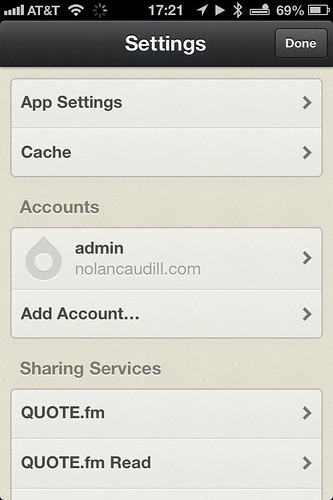A couple of months ago, my wife and I went on a two week vacation to Europe for our 5th wedding anniversary, splitting our time between Paris, Rome, and Cinque Terre. The first leg of our trip was in Paris where we spent a few days exploring the city. From there the plan was to take the TGV to Milan so we could see the Alps on our way to Vernazza.
Our destination after Paris was Milan–specifically the Porta Garibaldi station. This station is the main hub for the high-speed, long-distance trains like TGV. To get to Vernazza, once in Milan we had to transfer to another station, Milano Centrale. These two stations are less than a mile apart but with our luggage and general unfamiliarity with all things Italy, we gave ourselves over an hour to get from one station to the other. In the worst case, we could grab a cab. (Below is a map of Milan with P. Garibaldi on the west and Centrale under the marker.)
View Larger Map
In my research of planning this train ride, I discovered that you could buy full trips in advance, so I did. I had tickets that would take us from Paris to Milan, Milan to Sestri Levante, and from there onto Vernazza. I was confident, prepared, and had no idea I had already messed up.
The morning of the trip, we walked the mile from our apartment in the Bastille to Gare de Lyon. Gare de Lyon is a huge transit switching station, serving TGV, RER, as well as the Paris metro. If you are a train in Paris, this is your Champs-Élysées.

Our TGV train left on time and we were soon zooming through the French countryside. We sat in front of an older Australian couple, who both seemed to have generic digestive issues, belching loudly and passing gas, much to the dismay of the coutured French woman across the aisle from us, who would occasionally spritz her Chanel No. 5 in their direction which they, of course, didn’t notice.
The trip proceeded without event until we reached a small town at the foot of the mountains. Most of the stops we made were less than five minutes. This one dragged on for about ten minutes and there was a sense in the air that something wasn’t right. After about 15 minutes, a young, dark-haired girl walked into our car, crying and being escorted by one of the train attendants. They were speaking French but I got the sense she was looking for someone or something was wrong with her ticket. She eventually made her way out to the train platform and we left.
We trudged slowly up, and often through, the Alps. Eventually, one of the tunnels we went through popped us out into Italy. Upon exit of the tunnel, the train stopped. And we stayed stopped.
After about 20 minutes sitting less than a half a mile inside the Italian border, the conductor finally broke silence and announced that there was a medical emergency with one of our fellow travelers and we were waiting for an ambulanza. We sat for another 10-15 minutes while the medical staff attended to the sick person. After that was dealt with, the train started moving. The conductor said, through the PA that “we were delayed 16 minutes.” That wasn’t too bad. We still had about an hour to switch train stations.
Turns out “sixteen” and “sixty” sound approximately the same when said through a train’s PA system, spoken by a French train conductor whose second language was Italian and was giving a valiant attempt at English. I realized my mishearing after our arrival time came–and went–and we were in the middle of a giant field with no Milan in sight.

Not Milan. Photo courtesy of prof50000 on Flickr.
We arrived at Milano Porta Garibaldi with about 20 minutes to spare before our Milano Centrale train left. I switched to Optimistic Mode (aka: Denial Mode) and laced up my shoes, imbued a sense of urgency to my wife, and then sprinted through a foreign station in a foreign land to a foreign taxi stand. If stars aligned, and Lady Travel Luck smiled on us, we’d be resting comfortably in a Trenitalia train cruising towards our coastal town apartment in just a few minutes.
But, there were no cabs. There were signs outside the door pointing towards where taxis normally should be but now pointed to an empty stretch of asphalt. We waited for a few more minutes but I knew our window had closed and it was time to figure out Plan B.
My concern now switched to not just finding a new set of tickets into Vernazza but to find a way to get there that day. Vernazza, being a small town off the main line, didn’t have regular train service after 8pm and it stopped earlier than most stations. In my original booking, I knew there were only two or three trains after ours. Time was ticking.
My first priority was to buy tickets from where we were to where we wanted to be as quickly as possible and then see about getting a refund later on. I went to one of the self-serve kiosks, and after assistance from a 7 year-old girl and a college-aged art student who knew a little English, I gave another 80 euros to the Italian train system.
Now that I had tickets that ensured that we wouldn’t be sleeping in Milan, I queued up to speak to one of the station’s service agents about a refund for the missed train tickets. The line moved slowly as there were two agents, one of which seemed to know half-a-dozen languages and enjoyed to talk and the other that spoke what I would call “Gruff Train Agent Italian.” I managed to get the latter. I gave him both our original tickets and the ones I had just purchased, in hopes that it was evident what went down. He focused primarily on the new ones and indicated that I had plenty of time to catch that train. I kept signaling through the glass towards the original tickets but to no avail. I looked longingly at the multilingual agent and then shuffled back to my frazzled wife, beaten by the Italian train system.
Our new tickets left from that station and took us to yet another Milan train station. At this station, we found our platform with plenty of time to spare. We just had to stand there and our train would arrive. Or so I thought.
Literally two minutes before our train was to arrive, an announcement–in Italian–was made and everyone surrounding us on the platform quickly went to the stairs, went under the tracks, and went to the platform over. Our assumption was that our train had been switched to another platform. So we followed the crowd.
This was a mistake.
At the new platform, I looked at the sign that indicated the train number. The new sign didn’t match what was on our ticket but the old one still did. The train at the new platform pulled up and everyone around us got on. I overrode deep instinct and decided to not follow the herd of fellow Homo Sapiens. We sprinted back, burdened by our luggage, to the original platform.
A train arrived, its number matching the number on the sign matching the number on the ticket and we boarded. I was 90% sure we were on the right train.
On this particular train, the cars were split up into cabins that had 3 seats across from 3 seats. We made our way to our cabin and found our seats. The only issue was that there were two business men in expensive suits already situated comfortably in our seats. I was now 35% sure we were on the right train.
I had been generally confused about transit things for hours, was drenched in sweat from lugging around a large suitcase in the heat, and assumed that the comfortable-looking business people were in the right and we were on a train to somewhere that was not Vernazza. In desperation, I showed the two men our tickets. They sighed heavily and then an intricate social dance ensued. One man stood up and leaned over to the woman across the aisle from him that from my vantage point had nothing to do with our seats or our situation. She packed her belongings, and she and the other man left the cabin. The first man then took the seat of the woman, leaving Meghan and me two now-empty seats.
Since this leg of the trip was about 3 hours, I had plenty of time to contemplate what had transpired. In Italy, you can buy two kinds of tickets. The first is what we originally had: specific seats on a specific train on a specific date. The second is what everyone else in the country seemed to have: permission to ride a specific route within the next 3 months. With the latter, you grabbed a seat and if a reserved ticketholder came by, you moved to the next empty seat. My guess is that the man that took the woman’s seat had a reserved seat, had let her sit there, and once we interjected our American confusion into the whole thing, he sat in his assigned seat, bumping her to the next cabin.
Now riding calmly, I read my Kindle and stared out the window at the gorgeous seaside towns, even striking up a conversation with a young woman who was an economics major in Milan who gave us advice of things to do in Vernazza. Things were going well.
At one point, with my Kindle in my lap, I leaned over to say something to Meghan. My Kindle slid off my lap and into the crack between the seats and fell under my seat, out of reach. The 5 other people in the cabin–my wife included–wanted to see what the silly tourist was going to do next. I surprised them all: I gathered myself and then did absolutely nothing.
About an hour later, after a couple of people from our cabin had disembarked in Genoa, I had room to attempt to rescue my Kindle. I crouched down in this cramped cabin and began to fight with the seat. By everyone’s intense interest, I could tell even the regular Trenitalia travelers had no idea how the seats worked. After fiddling for a couple of minutes, I discovered the seats moved in a very non-intuitive way, giving me just enough room to slide my sweaty arm under the seat to a point where I could reach my Kindle. I pulled it out and held it up with a dramatic, “Ta-da!” Everyone was very impressed, I imagined.
We reached Sestri Levante after dark. We disembarked and I sprinted to the ticket punch machine to validate our tickets to Vernazza. (These were the second kind of tickets I mentioned earlier, where you don’t have a reserved seat. Before you ride though, you use a self-serve ticket punch machine to mark the ticket on the date of travel.) I punched the ticket, went to the video screen to figure out which platform we needed to be on. Vernazza wasn’t on the screen, and our train was supposed to arrive in less than 5 minutes. “Oh no,” I thought, “Not again.”
I ran back towards Meghan, prepared to just hop on whatever train came next and let come what may. I found her talking to a group of people that were obviously tourists, sporting sunburns and speaking English. Turns out that they not only spoke English, they were American. And not only that, but they were from the same small city in North Carolina that we lived in before moving to San Francisco. Best of all, though: they knew which platform the train to Vernazza would come into. We followed them to the platform, chatted a bit more, and once our train arrived, we boarded and collapsed into our seats.

After all that transit excitement, we spent three wonderful days exploring Cinque Terre and didn’t even bother looking into buying tickets for Rome until the morning we left.
What I learned from all this is that Italian trains are much closer to having schedules like buses and subways than airplanes. The system is built around things happening that change your plans. I learned not to expect to be in any station at any given time and instead buy my tickets for the next leg on the spot.
So when in Italy do as the Italians do: Relax and make your away across the country, one station at a time.









